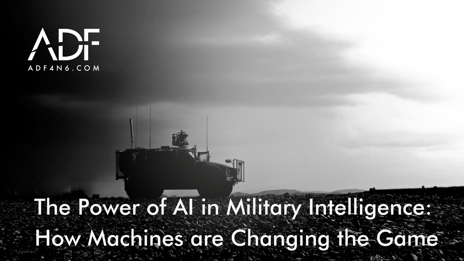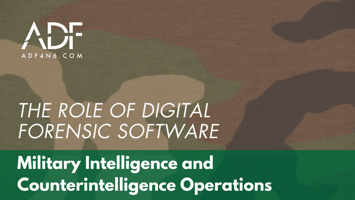The use of Artificial Intelligence (AI) to speed up corporate forensics investigations is becoming...
The Power of AI in Military Intelligence: How Machines Change the Game
In today's rapidly evolving global landscape, military intelligence is more critical than ever.
As conflicts become increasingly complex and challenging, militaries around the world are turning to cutting-edge technologies to gain an edge. One of the most promising of these technologies is artificial intelligence (AI).
According to the Breaking Defense E-book “AI is a key growth investment area for DoD, with nearly $1 billion allocated in the 2020 budget. The Defense Department’s Joint Artificial Intelligence Center (JAIC) will see its budget double to over $ 208 million, with significant increases likely in 2021 and beyond ... The military is currently seeking to integrate AI into weapon systems development, augment human operators with AI-driven robotic maneuver on the battlefield and enhance the precision of military fires” [1].
What is AI?
Artificial intelligence involves the use of computers to process large amounts of data. The AI system then analyzes the data for correlations and patterns to make future predictions [1]. With the use of machine learning models, AI can trace relationships between data points that may be too complex for the human mind. Large volumes of data are required for the systems to understand specific concepts and features to perform tasks.
Machine learning data and algorithms continue to gradually improve their accuracy over time. This is what allows AI systems to constantly provide usable data, perform tasks, and solve problems. Other techniques help AI systems exceed human performance, such as neural nets and deep learning. Deep learning uses neural networks as a method of teaching computers to process data similar to an animal brain [2].

The Benefits of AI in Military Intelligence
AI is transforming the way militaries gather and analyze intelligence, providing them with new tools to better understand their enemies and protect their own forces. Some of the key benefits of AI in military intelligence include:
- Improved speed and accuracy: AI systems can process massive amounts of data quickly and accurately, allowing military intelligence agencies to gain insights faster and more precisely.
- Gives systems the ability to react at gigahertz speed, which could also the overall pace and outcome of human combat.
- Enhanced situational awareness: AI-powered sensors and other technologies can help military intelligence agencies maintain a better understanding of the battlefield, providing them with a more complete picture of the enemy's capabilities and intentions.
- Unmanned Aerial Vehicles or UAVs combined with AI can be used to patrol border areas, identify possible threats, and transmit valuable information.
- Deep Fake technology includes the use of photo, audio, and video forgeries known as “deep fakes” as a method to create false news reports, and public discourse, erode public trust, and blackmail diplomats [3]. AI can be used to detect manipulations.
- Better resource utilization: By automating routine tasks, AI systems can free up human intelligence analysts to focus on more complex and strategic problems.
- Militaries can use computer vision and AI algorithms that analyze footage from UAVs and can automatically identify hostile activity. This would reduce the amount of time it would take a human to go through drone footage and obtain information [3]. Personnel could instead focus their time on making more efficient decisions based on the actionable information provided by AI.
- Reduced risk to human life: By relying on machines to perform dangerous or difficult tasks, militaries can reduce the risk to their personnel and increase their operational effectiveness.
- Autonomous systems are able to operate at higher efficiency and safety level. Militaries can implement AI into their unmanned systems and extend their robotic capabilities for navigation [1]. They can conduct dangerous reconnaissance missions without having to put their personnel at risk.
The Future of AI in Military Intelligence
As AI technologies continue to evolve, their impact on military intelligence is likely to grow. Some experts predict that AI systems will become increasingly integrated into military operations, providing decision-makers with real-time insights and enabling them to respond more quickly and effectively to threats.
The U.S. military has already begun integrating AI systems into combat through the Project Maven initiative. Project Maven has used AI algorithms to identify insurgent targets in Iraq and Syria [3]. In future developments, AI could be useful in identifying communication links that have been interrupted by enemies and finding alternative ways of distributing information.
With further AI research on machine learning models and computer research, militaries can look forward to several ways to apply AI. One future development is the possibility of using it in semiautonomous and autonomous vehicles. These include fighter aircraft, ground vehicles, and naval vessels [3]. AI technologies would help these vehicles better perceive their environment, obstacles, sensor data, plan navigation, and communication between vehicles.
AI may also be used to help vehicles accomplish their own independent tasks while following soldiers who are on the ground. The Army and Marine corps have worked on prototypes and plans to produce Robotic Combat Vehicles (RBCs) that have different autonomous capabilities such as IED removal, navigation, and surveillance [3].
Lethal autonomous weapon systems or LAWS are specialized weapons that use sensors and algorithms to identify a target independently and employ the weapon system to engage and destroy a target without human control [3]. These weapons would allow autonomy but still give humans the ability to exercise control and judgment over specific uses of force.
In conclusion, AI is proving to be a powerful tool in the field of military intelligence. From improved speed and accuracy to enhanced situational awareness and reduced risk to human life, the benefits of AI are many and far-reaching. AI is helping military intelligence agencies to make better, more informed decisions, and to respond more quickly and effectively to threats.
Researchers and experts in computer science continue to reduce the training time of AI systems and increase the quality of results.
With its ability to provide language translation, recognition of images, and recommendations, they continue to improve and just nearly reach human-level achievements. The future of military intelligence is inextricably linked to the power of artificial intelligence (AI). AI has the potential to revolutionize how militaries gather, analyze, and act on information. In the future, AI will be used to power sophisticated surveillance systems.
AI will also be used to analyze vast amounts of data to uncover patterns and identify potential threats. They will also be able to respond faster and more accurately to changing battlefield conditions. In short, AI will give militaries the power to know more, see more, and act faster than ever before.
However, in order to fully realize the potential of AI in military intelligence, it's important to have the right tools and technologies in place for enhancing AI's capabilities. One such technology is digital forensic software that makes use of AI to automate and streamline the process of gathering and analyzing digital evidence. By investing in these tools, military intelligence agencies can improve their operational effectiveness, reduce their risk, and make better use of their resources.





